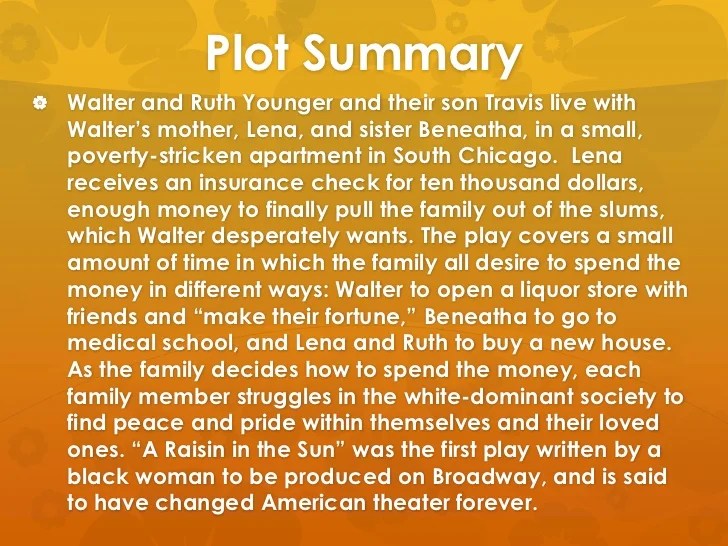Script of a raisin in the sun – Step into the captivating world of ‘A Raisin in the Sun,’ a groundbreaking play that delves into the complexities of race, poverty, and the American Dream. With its profound characters and thought-provoking themes, this masterpiece continues to resonate with audiences today.
Through the experiences of the Younger family, we witness the struggles and aspirations of African Americans in the midst of the Civil Rights Movement. The play’s title, ‘A Raisin in the Sun,’ serves as a powerful metaphor, symbolizing both the challenges and the hope that the family faces.
Characters and their Relationships

The play’s central characters are the Younger family, an African American family living in a cramped apartment in Chicago’s South Side.
Walter Lee Younger, the protagonist, is a proud and ambitious man, but his dreams are stifled by the realities of poverty and racial discrimination. He is driven by a desire to provide a better life for his family, but his frustrations often lead to conflict.
Lena Younger, Walter’s mother, is a strong and resilient matriarch. She is the glue that holds the family together and provides a sense of stability and tradition.
Beneatha Younger, Walter’s sister, is a bright and independent young woman. She is determined to make her own way in the world and is not afraid to challenge societal norms.
The complex relationships between the characters shape the plot and drive the play’s themes. The family’s struggle for economic and social equality is reflected in their interactions with each other.
Role of Family and Community
Family and community play a vital role in the play. The Younger family is a close-knit unit, and their love and support for each other help them to overcome challenges.
The community also provides a sense of belonging and support. The Youngers are surrounded by neighbors who share their experiences and offer a helping hand.
Themes and Symbolism: Script Of A Raisin In The Sun

The play “A Raisin in the Sun” delves into profound themes that resonate with the complexities of human experience, particularly within the context of race, poverty, and the pursuit of the American Dream. These themes are interwoven through the characters’ personal journeys, interactions, and the symbolic significance of the play’s title.
Race and Identity
The play confronts the pervasive issue of racial discrimination and its impact on the lives of the Younger family. The characters navigate a society that restricts their opportunities and perpetuates stereotypes, forcing them to grapple with their sense of identity and self-worth.
- Walter’s internal conflict stems from his desire for financial success and recognition, which he believes will validate his manhood and overcome the barriers imposed by racial prejudice.
- Beneatha’s quest for cultural identity and self-expression is explored through her embrace of African heritage and her refusal to conform to societal expectations.
Poverty and Social Inequality
The play vividly portrays the challenges faced by the Younger family as they live in poverty. Their financial struggles limit their options and trap them in a cycle of deprivation.
- The family’s cramped living conditions in a small apartment symbolize their economic hardship and the lack of opportunities available to them.
- Walter’s desperate attempt to invest in a liquor store as a way out of poverty highlights the limited options available to African Americans at the time.
The American Dream and its Limitations
The play explores the allure and limitations of the American Dream for the Younger family. While they strive to achieve financial stability and social acceptance, they face obstacles that test their beliefs.
- Walter’s ambition to become a wealthy businessman is a reflection of the promise of the American Dream, but his setbacks and disappointments expose the racial and economic barriers that hinder its realization.
- The family’s ultimate decision to purchase a house symbolizes their determination to overcome adversity and pursue their dreams, even if they are aware of the challenges that lie ahead.
Symbolism, Script of a raisin in the sun
The play employs powerful symbolism to convey its themes and messages.
- The Raisin: The title of the play refers to a dried-up raisin, which represents the family’s struggles and the challenges they face in achieving their dreams.
- The Sun: The sun symbolizes hope and the possibility of a brighter future. It is a beacon of light that guides the family through their darkest moments.
Structure and Language

The play is structured into three acts, each with several scenes. This structure allows the playwright to explore the different aspects of the Younger family’s lives and the challenges they face. The first act introduces the family and their dreams, the second act shows the family struggling to achieve their goals, and the third act reveals the consequences of their decisions.The
playwright uses a variety of language, including dialect and vernacular, to create a realistic and authentic portrayal of the Younger family. The characters speak in the way that people from their background would speak, which helps to bring them to life and make them relatable to the audience.
The use of dialect and vernacular also helps to create a sense of place and time, and to evoke the atmosphere of the South Side of Chicago in the 1950s.The structure and language of the play contribute to its overall impact by creating a sense of realism and authenticity.
The audience is able to connect with the characters and their struggles, and to understand the challenges that they face. The play’s structure also helps to build suspense and tension, and to create a sense of catharsis at the end.
Exploring the complexities of human relationships and societal norms, “A Raisin in the Sun” resonates with its timeless themes. However, stepping away from its poignant narrative, we delve into the realm of chemistry with an acid-base titration pre-lab ( here ). This scientific endeavor offers insights into the fundamental principles of acid-base reactions, paving the way for a deeper understanding of the play’s own transformative power.
Use of Dialect and Vernacular
The playwright’s use of dialect and vernacular is essential to the play’s realism and authenticity. The characters speak in the way that people from their background would speak, which helps to bring them to life and make them relatable to the audience.
The use of dialect and vernacular also helps to create a sense of place and time, and to evoke the atmosphere of the South Side of Chicago in the 1950s.For example, the character of Walter Lee Younger often speaks in a dialect that is characteristic of African Americans from the South Side of Chicago.
He uses words like “ain’t” and “gonna,” and he drops his “g”s at the end of words. This dialect helps to create a sense of authenticity and realism, and it also helps to establish Walter Lee as a character who is rooted in his community.
Historical and Cultural Context

A Raisin in the Sunis a play written by Lorraine Hansberry in 1959. It is set in Chicago’s South Side during the Civil Rights Movement and the Great Depression. The play tells the story of the Younger family, an African-American family who is struggling to make ends meet.
The Civil Rights Movement was a period of social activism that aimed to end racial discrimination and segregation in the United States. The Great Depression was a period of economic crisis that began in 1929 and lasted until the late 1930s.
Relevance to Contemporary Social Issues
A Raisin in the Sunis still relevant to contemporary social issues. The play addresses issues such as racism, poverty, and the struggle for equality. These issues are still relevant today, as there is still racial discrimination and poverty in the United States.
Reflection of the Cultural and Social Landscape
A Raisin in the Sunreflects the cultural and social landscape of its time. The play shows the struggles that African Americans faced during the Civil Rights Movement and the Great Depression. The play also shows the strength and resilience of the African-American community.
Essential FAQs
What is the significance of the title ‘A Raisin in the Sun’?
The title is taken from a poem by Langston Hughes and symbolizes the challenges and aspirations of African Americans in the midst of the Civil Rights Movement.
Who is the main character in ‘A Raisin in the Sun’?
The play centers around the Younger family, with Walter Lee Younger as the protagonist.
What are the major themes explored in ‘A Raisin in the Sun’?
The play explores themes such as race, poverty, the American Dream, family, and community.
